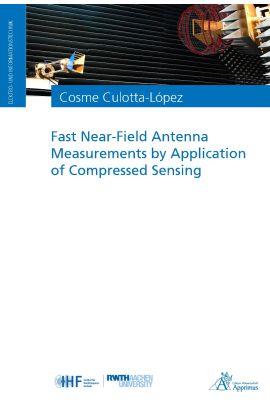With a higher demand of communication systems and the ever-growing presence of connected devices, the need for antenna measurements increases accordingly. A particularly convenient method to measure antennas is to do it in their near field, which allows us to measure them in smaller facilities. To acquire a full, three-dimensional representation of the antenna's radiation characteristics, spherical near-field measurements are performed. The inconvenience of this type of measurements compared to a direct acquisition of the antenna's far field is that, to be able to calculate the far field from the near field, a mathematical calculation involving the retrieval of the so-called spherical mode coefficients is required. This, in turn, demands a high number of measurement points, and thus a long measurement time. The vector described by the spherical mode coefficients, however, proves to have, for most physical antennas in typical measurement situations, a large number of zero-terms, meaning the full information is contained in only a few significant terms, i.e., it is sparse. A sparse vector enables the reconstruction from a set of fewer measurement points, which can potentially accelerate measurements.
In this work, the minimum-coherence of the sampling matrix is used as criterion for reconstructability. The lower coherence bound of sampling matrices of the spherical near-field problem's basis functions is derived for a distribution in elevation chosen to enable fast scanning. The corresponding pairs in azimuth that reach this bound are calculated with an iterative algorithm. To increase the efficiency of the proposed compressed sampling, the acquisition of additional samples on the scanning path is suggested.
To apply the studied techniques to other geometries, the sampling points are projected onto arbitrary surfaces using the technique known as pointwise probe correction. The suggested method not only enables the use of compressed sensing for already-existing positioner systems, but also for arbitrary surfaces in modern systems, such as industrial robotic arms.
Further, other practical considerations are briefly discussed and a technique to adaptively choose the number of measurement points is suggested.
Finally, the application of compressed-sensing techniques to phaseless spherical near-field antenna measurements is introduced and briefly discussed, paving the way for further research in this direction.
| Autor | Culotta-López, Cosme |
|---|---|
| Gewicht | 0.24 kg |
| Erscheinungsdatum | 01.04.2021 |
Eigene Bewertung schreiben
Elektro- und Informationstechnik
Fast Near-Field Antenna Measurements by Application of Compressed Sensing
ISBN: 978-3-86359-956-0
Lieferzeit:
39,00 €
inkl. 7% MwSt.
Kurzbeschreibung
In this work, a compressed sampling based on the minimum-coherence of the sampling matrix is used to accelerate spherical near-field measurements. To increase the efficiency of the proposed compressed sampling, the acquisition of additional samples on the scanning path is suggested. This sampling is extended to arbitrary geometries using pointwise probe correction, and a technique to adaptively choose the number of measurement points is suggested.
Auf Lager

